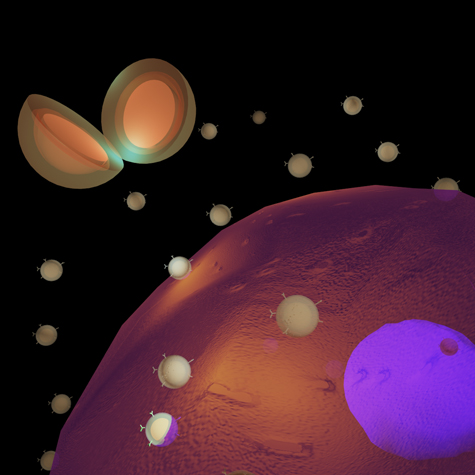
Called BRIGHTs, the tiny probes described in the online issue of Advanced Materials on Nov. 15, bind to biomarkers of disease and, when swept by an infrared laser, light up to reveal their location.
Tiny as they are, the probes are exquisitely engineered objects: gold nanoparticles covered with molecules called Raman reporters, in turn covered by a thin shell of gold that spontaneously forms a dodecahedron.
The Raman reporters are molecules whose jiggling atoms respond to a probe laser by scattering light at characteristic wavelengths.
The shell and core create an electromagnetic hotspot in the gap between them that boosts the reporters’ emission by a factor of nearly a trillion.
BRIGHTs shine about 1.7 x 1011 more brightly than isolated Raman reporters and about 20 times more intensely than the next-closest competitor probe, says Srikanth Singamaneni, PhD, assistant professor of mechanical engineering and materials science in the School of Engineering & Applied Science at Washington University in St. Louis.
Goosing the signal from Raman reporters
Singamaneni and his postdoctoral research associate Naveen Gandra, PhD, tried several different probe designs before settling on BRIGHTS.
Singamaneni’s lab has worked for years with Raman spectroscopy, a spectroscopic technique that is used to study the vibrational modes (bending and stretching) of molecules. Laser light interacts with these modes and the molecule then emits light at higher or lower wavelengths that are characteristic of the molecule,
Spontaneous Raman scattering, as this phenomenon is called, is by nature very weak, but 30 years ago scientists accidently stumbled on the fact that it is much stronger if the molecules are adsorbed on roughened metallic surfaces. Then they discovered that molecules attached to metallic nanoparticles shine even brighter than those attached to rough surfaces.
The intensity boost from surface-enhanced Raman scattering, or SERS, is potentially huge. “It’s well-known that if you sandwich Raman reporters between two plasmonic materials, such as gold or silver, you are going to see dramatic Raman enhancement,” Singamaneni says.
Originally his team tried to create intense electromagnetic hot spots by sticking smaller particles onto a larger central particle, creating core-satellite assemblies that look like daisies.
“But we realized these assemblies are not ideal for bioimaging,” he says, “because the particles were held together by weak electrostatic interactions and the assemblies were going to come apart in the body.”
Next they tried using something called Click chemistry to make stronger covalent bonds between the satellites and the core.
“We had some success with those assemblies,” Singamaneni says, “but in the meantime we had started to wonder if we couldn’t make an electromagnetic hot spot within a single nanoparticle rather than among particles.
“It occurred to us that if we put Raman reporters between the core and shell of a single particle could we create an internal hotspot.”
That idea worked like a charm.
A rainbow of probes carefully dispensing drugs?
The next step, says Singamaneni, is to test BRIGHTS in vivo in the lab of Sam Achilefu, PhD, professor of radiology in the School of Medicine.
But he’s already thinking of ways to get even more out of the design.
Since different Raman reporter molecules respond at different wavelengths, Singamaneni says, it should be possible to design BRIGHTS targeted to different biomolecules that also have different Raman reporters and then monitor them all simultaneously with the same light probe.
And he and Gandra would like to combine BRIGHTS with a drug container of some kind, so that the containers could be tracked in the body and the drug and released only when it reached the target tissue, thus avoiding many of the side effects patients dread.
Good things, as they say, come in small packages.